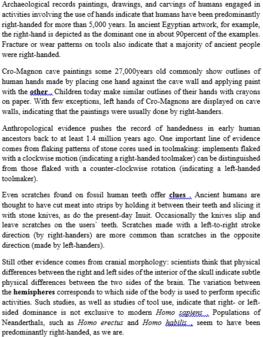Read the following passage and mark the letter A, B, C, or D on your answer sheet to indicate the correct answer to each of the questions from 35 to 42
It is hard to think of a world without gas or electricity. Both are commonly used for lighting and heating today. We now can instantly flick a lighter or strike a match to make a flame. But it was not long ago that there were no such things as matches or lighters. To make fire, it was necessary to strike a piece of iron on flint for sparks to ignite some tinder. If the tinder was damp, or the flint old, you had to borrow some fire from a neighbor.
We do not know exactly when or how people first used fire. Perhaps, many ages ago, they found that sticks would burn if they were dropped into some hole where melted lava from a volcano lay boiling. They brought the lighted sticks back to make their fire in a cave. Or, they may have seen trees catch fire through being struck by lightning, and used the trees to start their own fires.
Gradually people learned they could start a fire without traveling far to find flames. They rubbed two pieces ot wood together. This method was used for thousands of years.
When people became used to making fires with which to cook food and stay warm at night, they found that certain resins or gums from trees burnt longer and brighter. They melted resins and dipped branches in the liquid to make torches that lit their homes at night. Iron stands in which torches used to be fixed can still be seen in old buildings of Europe.
There was no lighting in city streets until gas lamps, and then electric lamps were installed. Boys ran about London at night carrying torches of burning material. They were called torch boys, or link boys, and earned a living by guiding visitors to friends’ houses at night.
For centuries homes were lit by candles until oil was found. Even then, oil lamps were no more effective than a cluster of candles. We read about the splendors and marvels of ancient palaces and castles, but we forget that they must have been gloomy and murky places at night
The word “gloomy” in the passage is closest in meaning to ________.
A. nearly dark
B. badly decorated
C. containing a lot of white
D. mysterious



Đáp án A
A. tối tăm
B. được trang trí tệ
C. có nhiều màu trắng
D. huyến bí
Thông tin trong bài đọc: “We read about the splendors and marvels of ancient palaces and castles, but we forget that they must have been gloomy and murky places at night.” (Chúng ta biết được về những vật lộng lẫy của cung điện và lâu đài, nhưng quên rằng đó chắc hẳn là những nơi tối tăm và ảm đạm vào ban đêm.)
Vậy gloomy” ~ nearly dark